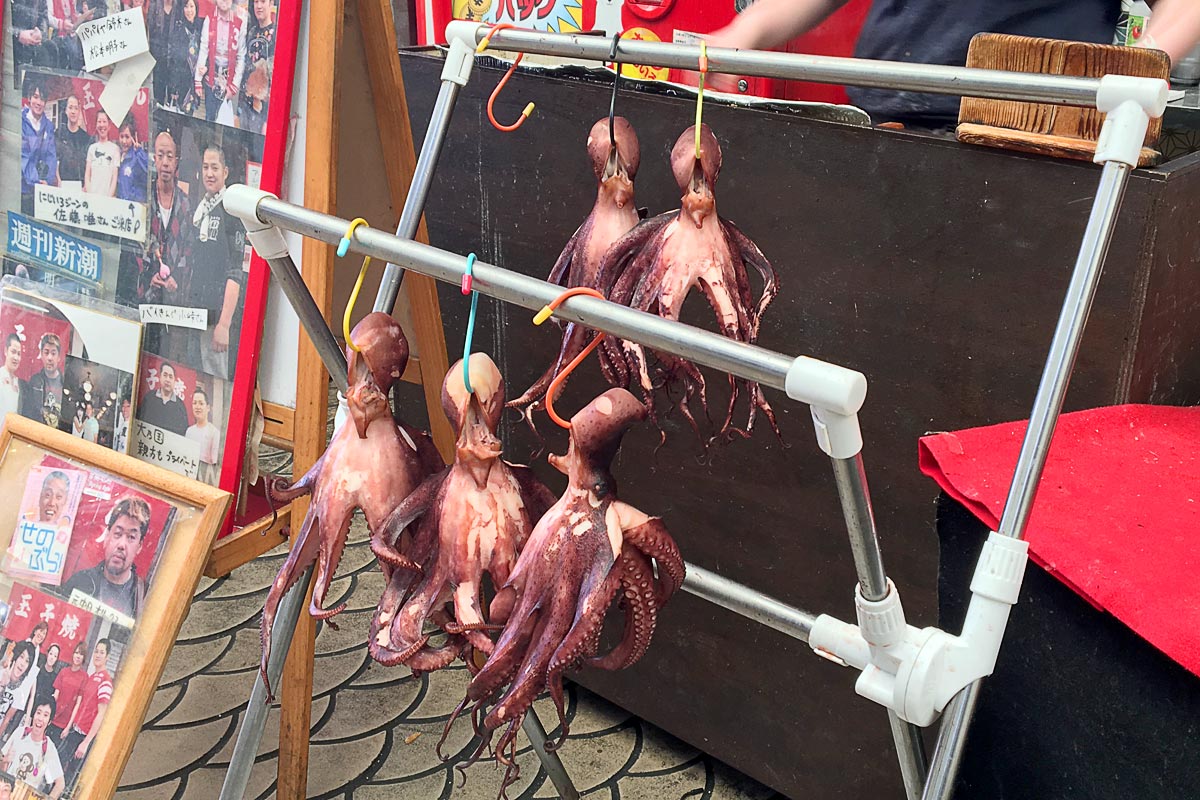
Please leave us here
Close our eyes
To the octopus ride
—Syd Barrett
Blood sugar meter, insulin pens, and low BG snacks in hand, I recently went with my travel partner Masayo to a town called Akashi (明石), just past Kobe east of Osaka, Japan. Someone had told me of the special version of takoyaki (fried balls with chunks of octopus in them) there colloquially called Akashi-yaki (by outsiders, anyway). And I’d never been there: always a plus when a traveler is choosing a destination.
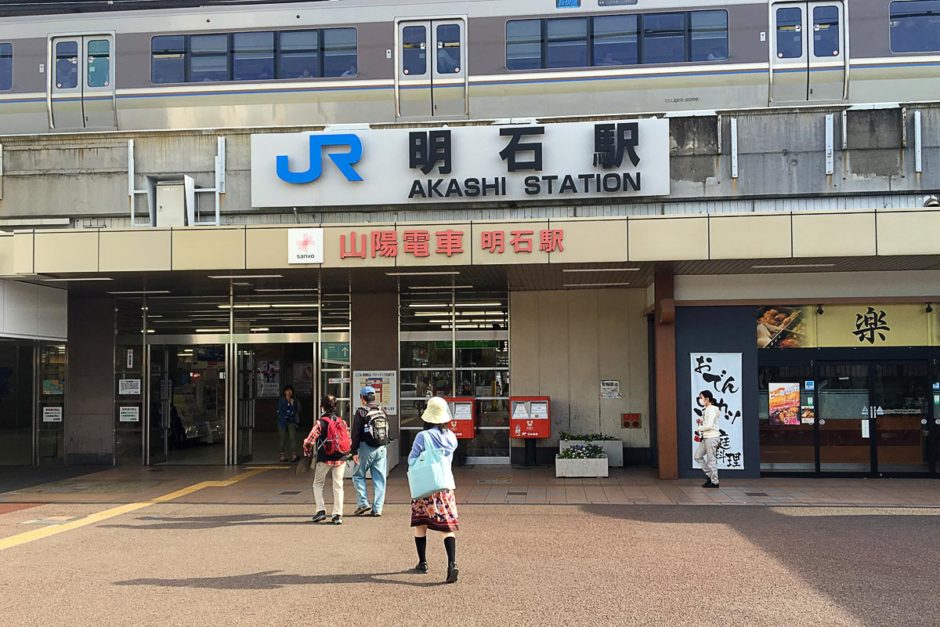
We took the JR train about an hour from Osaka to Akashi station, and right away I could see we were in for a day of seafood: Akashi is right on the coast of the Seto Inland Sea which we could see right outside the train for the last half of the trip, and a big fish figurine on a pole sat right outside the train station. You can see it from the platform.
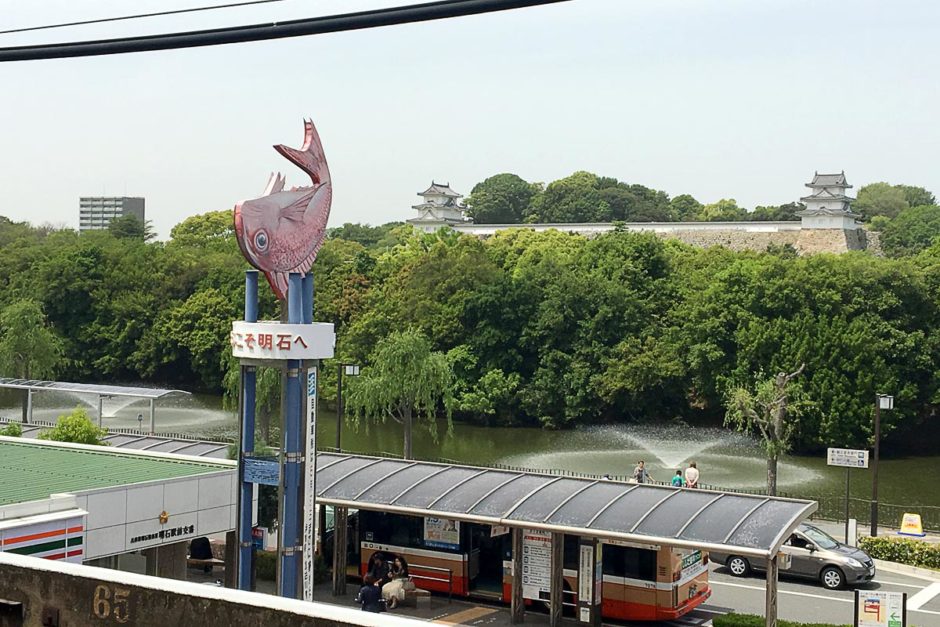
Seafood is indeed the story in Akashi: the famous covered shopping street there is full of seafood vendors, almost to the exclusion of all other types of shops. (Covered shopping streets are everywhere in Japan, and often include clothes stores, kitchen gadgets, restaurants and cafes, book stores, and everything else. This one was all seafood, plus a lone Italian restaurant for some reason.)
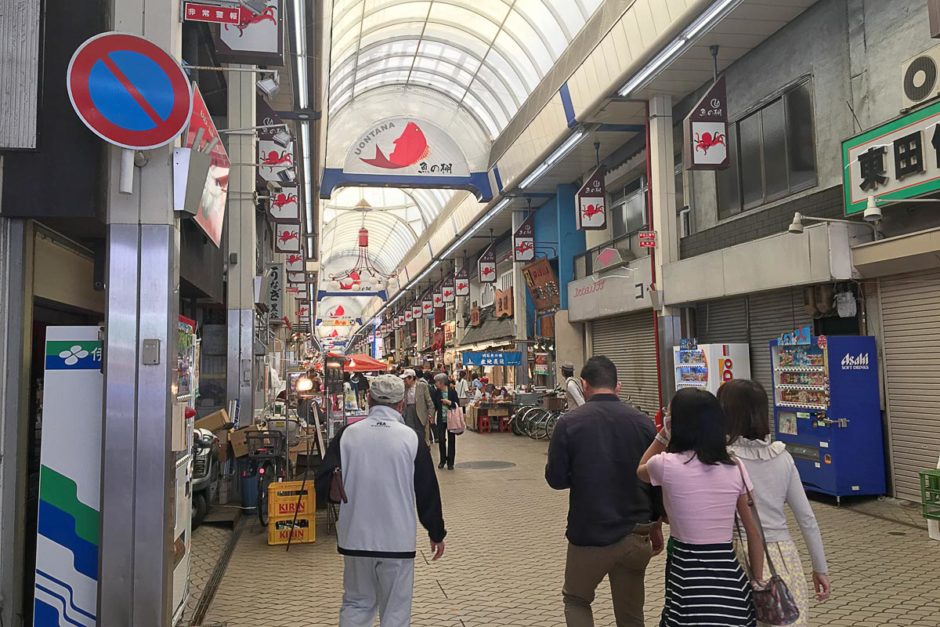
Entire octopuses, large, mutely staring fish, and even some fried tempura on sticks were everywhere. Vendors called out to passing pedestrians, hoping to sell some of their very fresh-looking wares. In one part of the shopping arcade a bunch of cardboard boxed were set up and covered to create a maze for kids to crawl around in. Not many kids were there. A radio was playing “Nights In White Satin” by the Moody Blues. It didn’t really go with the sunny Sunday afternoon vibe, but whatever.
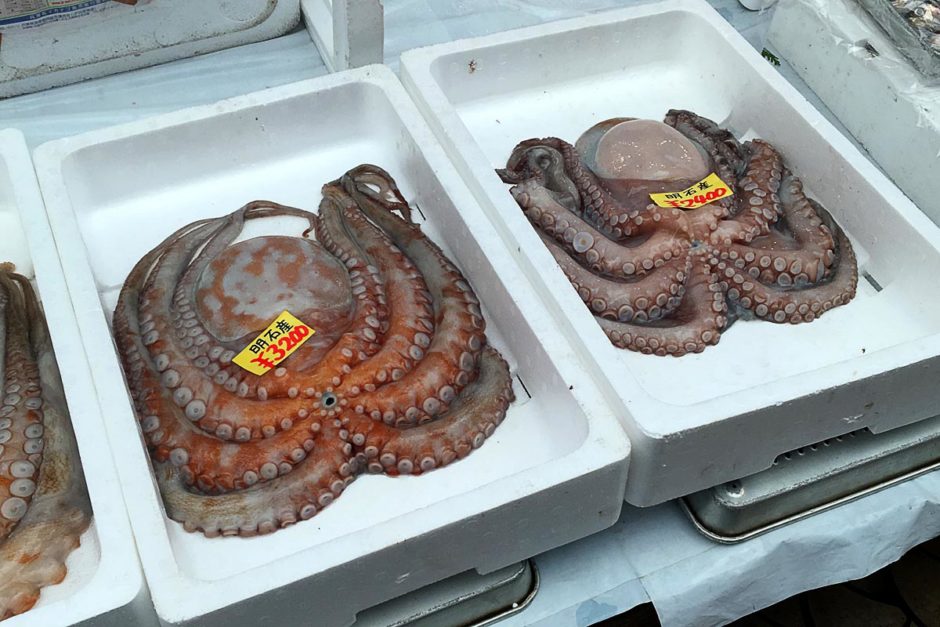
Although the fish and the octopus and the piles of seaweed looked good, Masayo and I were there for one thing only: so-called Akashi-yaki, Akashi’s special takoyaki.
We settled on a little restaurant that seemed popular but had a free table. I ordered the set meal that came with rice, and they soon brought our food: we each got a piece of smooth light-colored wood, propped up with a bar on the underside of the top, on which fifteen pieces of takoyaki sat. Beside them, in a bowl, was an almost clear fish stock soup into which you put cilantro.
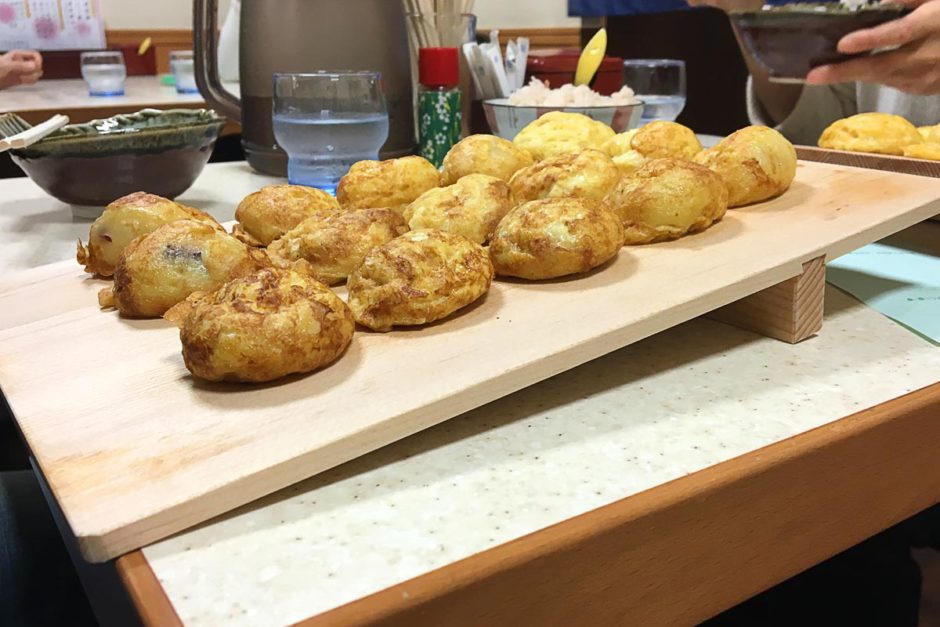
What makes Akashi-yaki special is that, while you just put sauce on takoyaki and eat it in Osaka, you dip the takoyaki balls in the soup in Akashi and have them wet. It’s more fishy that way, and less savory since there is no sauce.
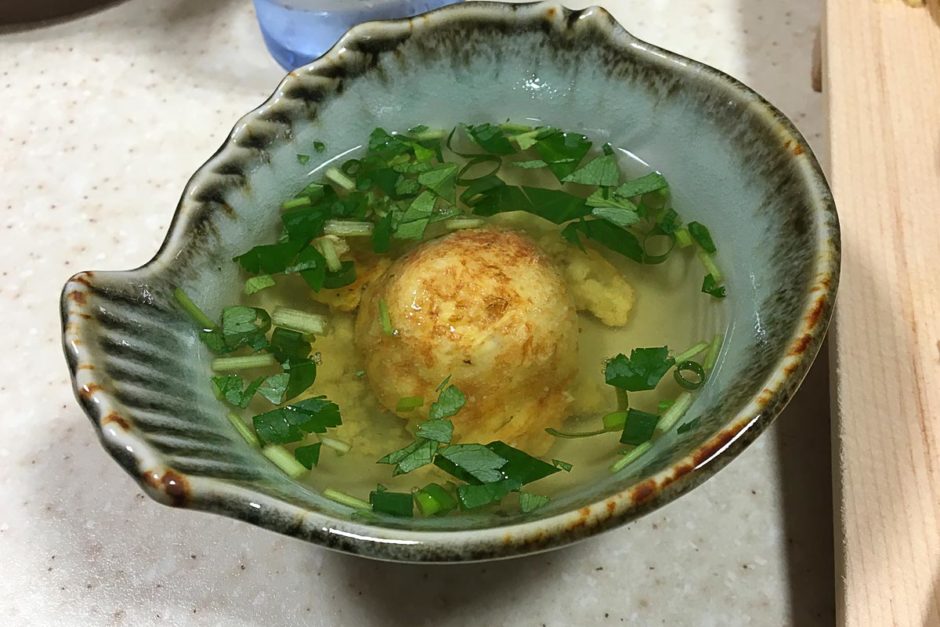
Even my rice had little bits of purple octopus mixed in it.
The takoyaki was hard to pick up – some of it was still really hot and just melted off of our chopsticks, or disintegrated in the soup. But we each got the hang of it. It was indeed fishy, and very tasty.
But my blood sugar had been only 59 about an hour earlier, and while I’d had some juice, I didn’t feel right about taking insulin yet, so I continued eating.
Anyway, how much insulin do you take for octopus balls?
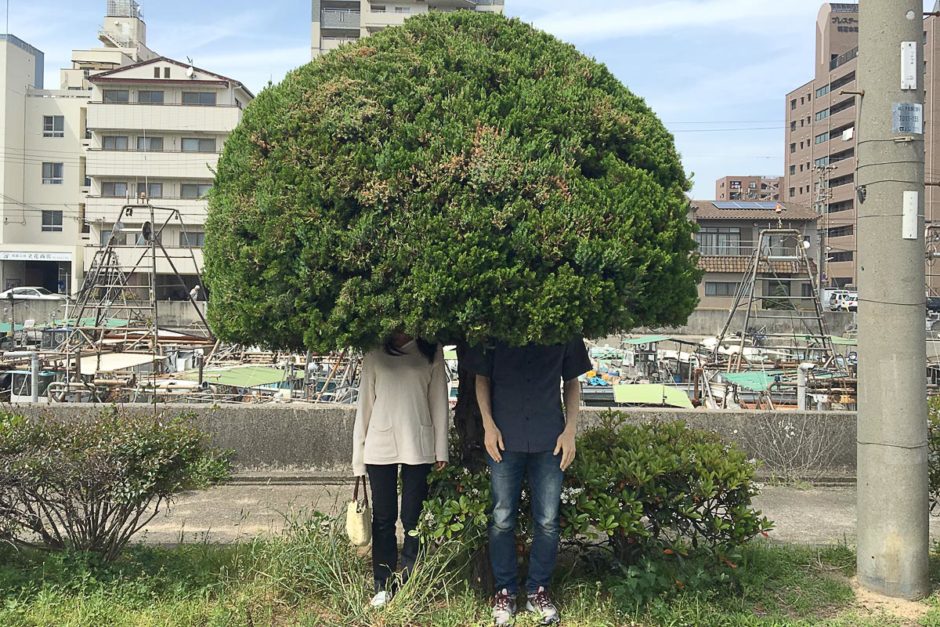
I knew that octopus balls, like the Kansai region’s other famous food okonomiyaki, was made from flour and was quite a bit higher in carbs than you might think. I figured about 60 grams of carbs for the 15 takoyakis, plus several more units for the rice.
After I was done, I felt ok about shooting up, and went and did so in the bathroom. Nine units.
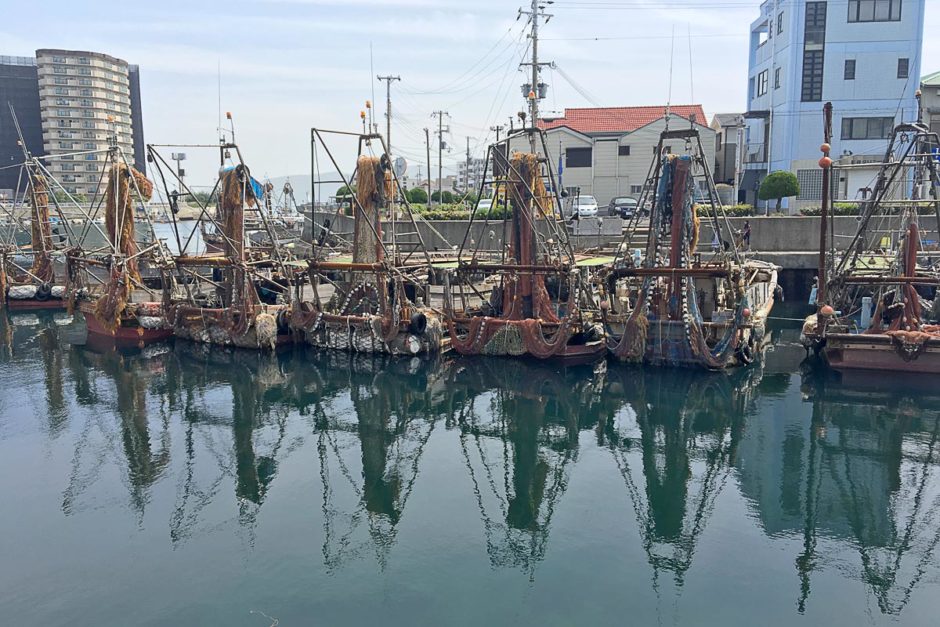
When I paid, I tried to get into a casual conversation with the chef (who was working the register) about how he made his Akashi-yaki. He said there was no flour – it was in fact tamago-yaki we had ordered, made from eggs. Plus some ingredient whose name I didn’t understand.
Uh-oh. Did I take too much insulin?
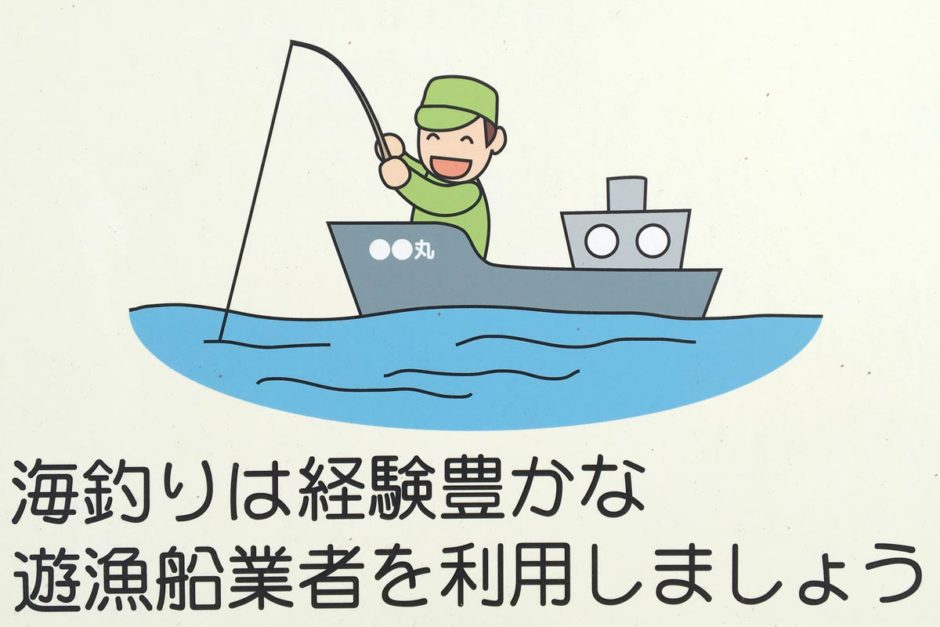
I saw people fishing, but they didn’t look quite this merry.
I promised that I would be careful and check my BG soon, but we went walking around the seaside of Akashi after lunch. The first thing we saw was the oldest lighthouse in the world. Wait, sorry, no it was the oldest lighthouse in Japan.
OK, actually it was the oldest extant stone lighthouse in Japan. Despite all the qualifiers, it was pretty cool, about 400 years old and shaped with stones in the style of castle walls in Japan: curving outward as they reach the ground.
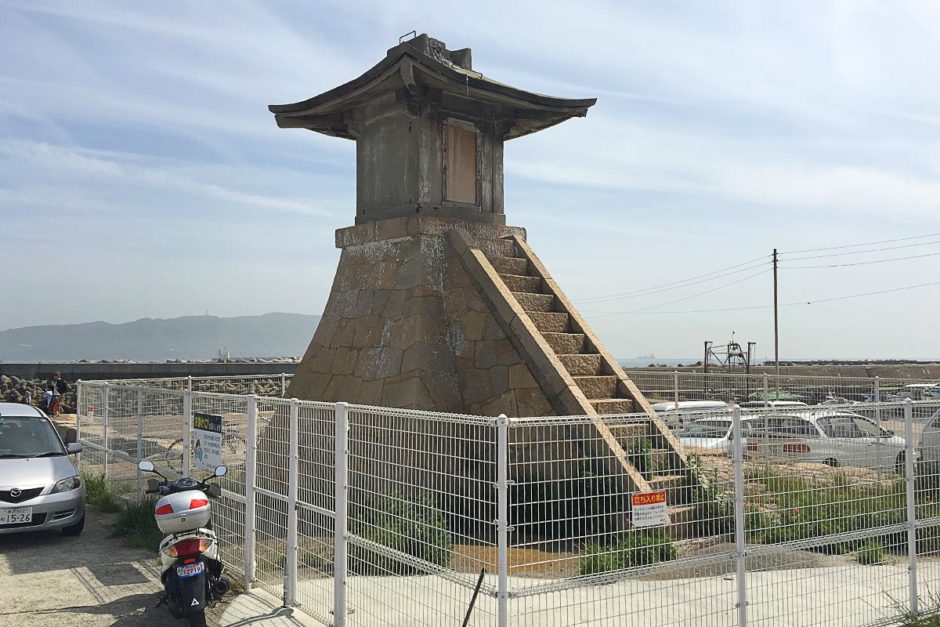
Behold, the oldest stone lighthouse in Japan.
Beyond the lighthouse was a new but not much bigger lighthouse, at the end of a long pier from which people were fishing for their dinner. Nobody seemed to be catching anything, but the sea life was everywhere: kelp bobbed in the water and lichen clung to every concrete surface, which were many due to the huge tetrapods thrown into the water to prevent erosion (or something). Fleets of fishing boats sat side by side in harbors, draped with nets and rusted chains. Salt-eroded bicycles waited bent in the sun for their owners to return from fishing.
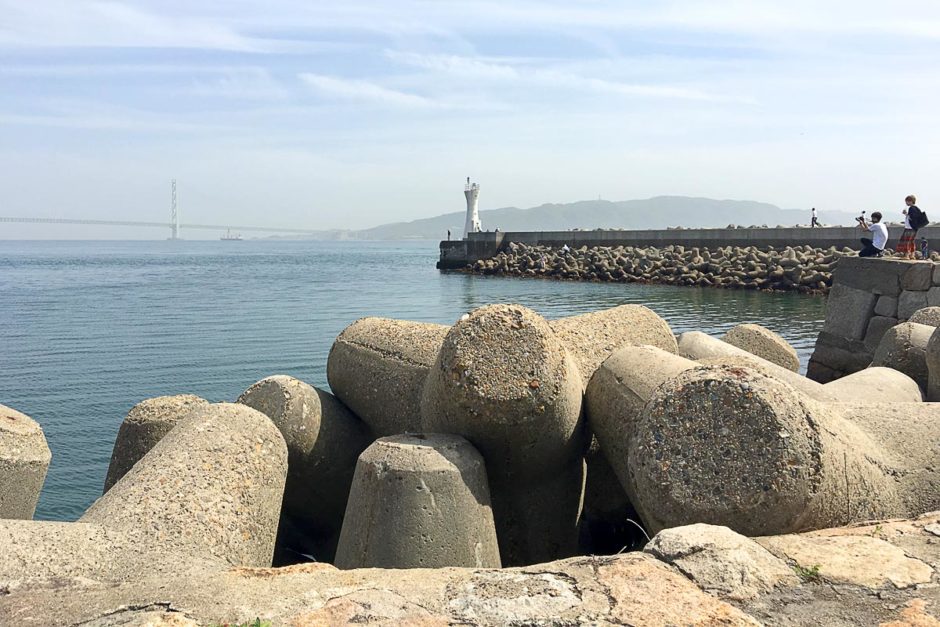
The huge Awaji Kaikyō Bridge is on the left, beyond the new lighthouse and the concrete tetrapods of the Akashi shore. The land mass in the far distance is hilly Awaji Island.
Oddly, there weren’t any seagulls around. But we could see the huge Akashi Kaikyō Bridge which links the main island of Honshu to the island of Awaji. The bridge has the longest central span of any bridge in the world – just a hair under two kilometers. It was a sunny day and we could see Awaji fading into the mist in the distance.
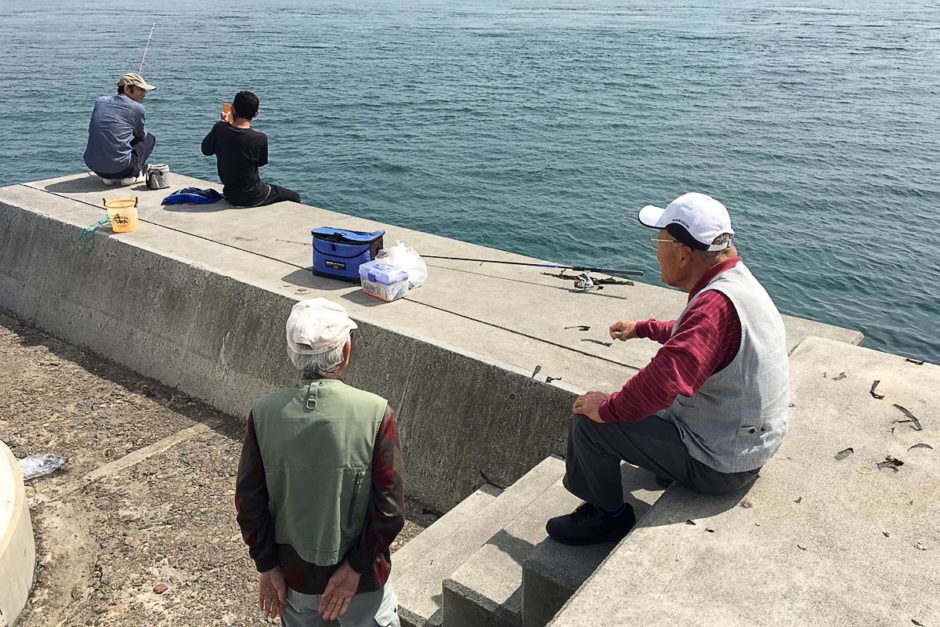
I was feeling low, although my shot had been about an hour ago, and checked: 76. Sigh. I think those octopus balls had less carb content than I thought. I had some chocolate.
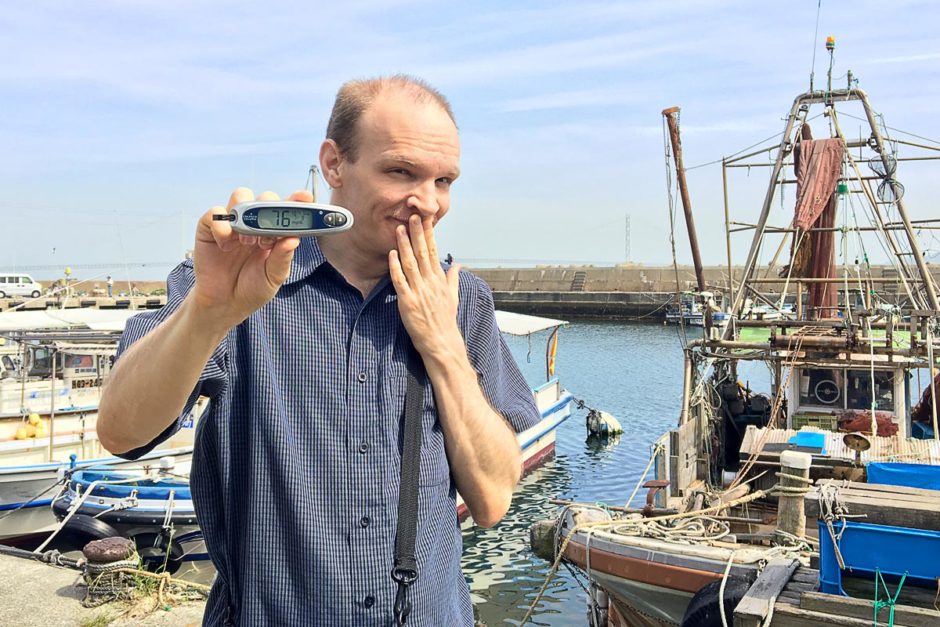
The other thing in this part of Akashi is a series of temples and shrines, some tiny and some a little bigger. We walked around residential streets at random coming across temples – the weather was excellent on this May day by the seaside, and though I was somewhat preoccupied with my blood sugar, the temples were really nice to visit. Nobody else seemed to be here, certainly no tourists like us.
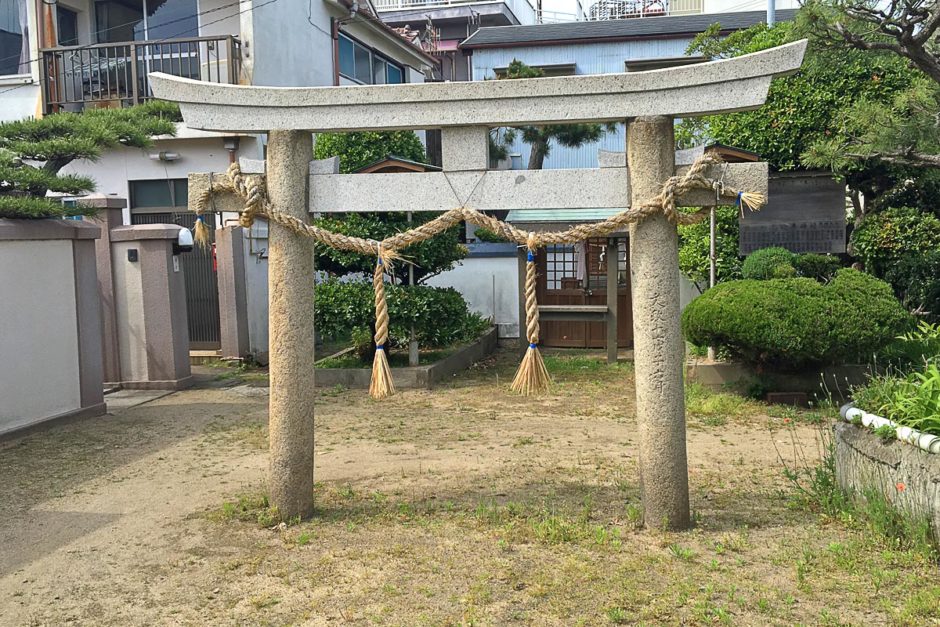
Finally we stopped by a park called Akashi Castle Park. I didn’t know Akashi even had a castle, but the little park was nice. Out front, a local politician was holding a megaphone, wearing a sash, and giving a speech. Not a single person was listening. But he kept on.
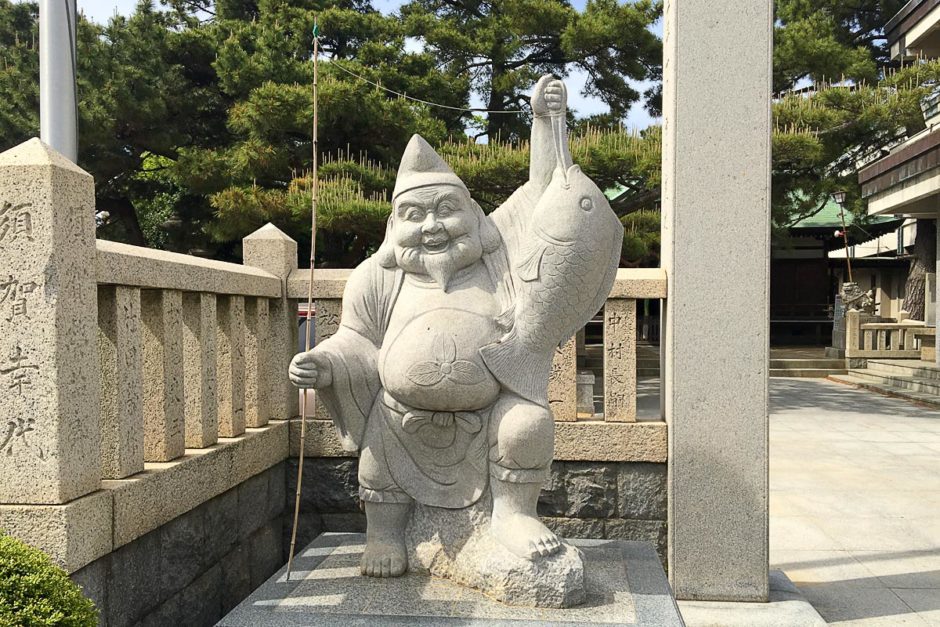
Like others, Masayo and I sat right on the cool grass and relaxed under the sun. Kids ran around playing while families had picnics; both the shade and the sunlight offered nice weather for it. Someone with a clipboard approached Masayo, taking a survey about political affiliation. Masayo checked a box and the guy thanked her and went to ask someone else.
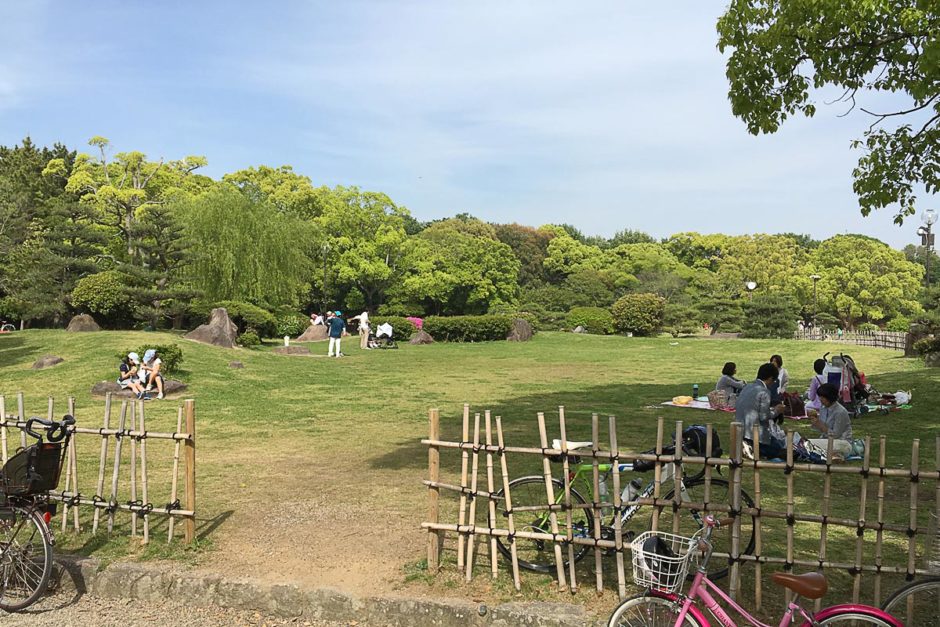
Then we hiked up a long series of wide steps to Akashi Castle, which turns out to be gone. There was a castle at some point, but now it’s just a field with trees and big stones to sit on. Two of the guard towers are still there, and one is a tiny free museum. When we arrived the two old men staffing it said we could go in but we only had three minutes before closing time.
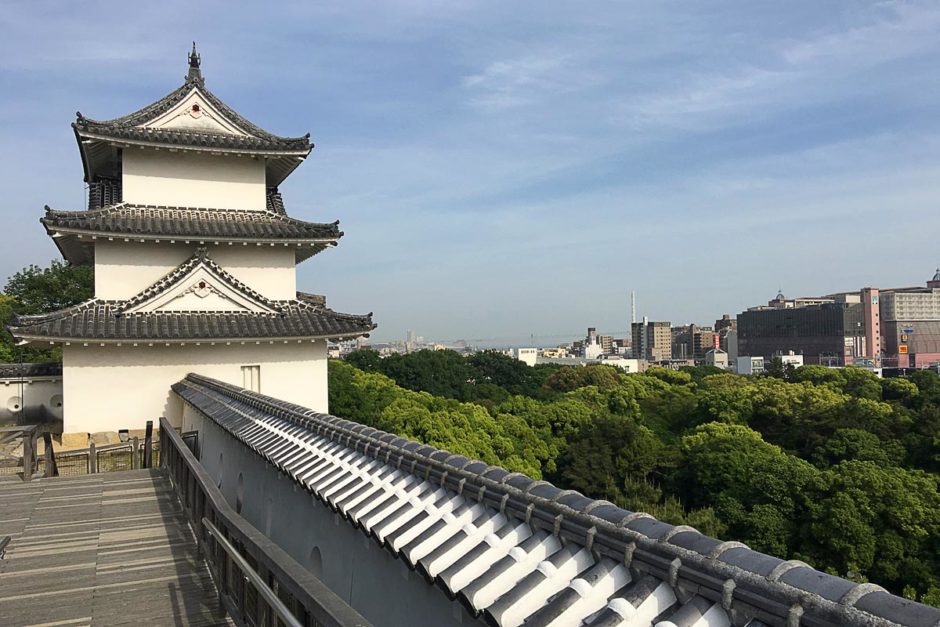
That’s all it really takes though; it’s one room with some of the original tiles from the castle, plus several models of other area castles and a big diorama of the land as it used to be: you could see the sea and the little houses in their well-ordered little lanes.
As we were leaving, after about three minutes, another couple was just arriving. I heard the staff telling them “you only have two minutes”. They also gave me an explanatory piece of blue paper in English about the history of the construction of the castle. Oddly, the reason the castle no longer stood wasn’t addressed. Maybe it’s a secret.
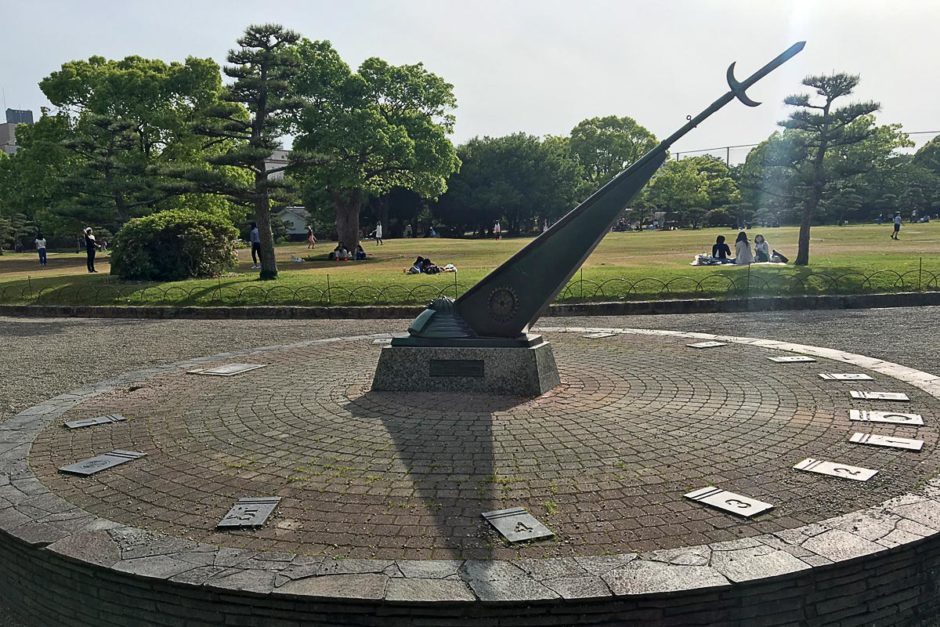
Sundial in Akashi. This photo was taken at 4:14. Not bad huh?
It had been 90 minutes after the 76 and on the spot of the ex-castle I checked again: 67. Sigh again. More juice, but I was careful not to overdo it. I have gotten into a bad habit of ignoring carb counts when I’m low and just drinking entire bottles of juice. So this time I was careful and just had what I thought would bring me up to about 100.
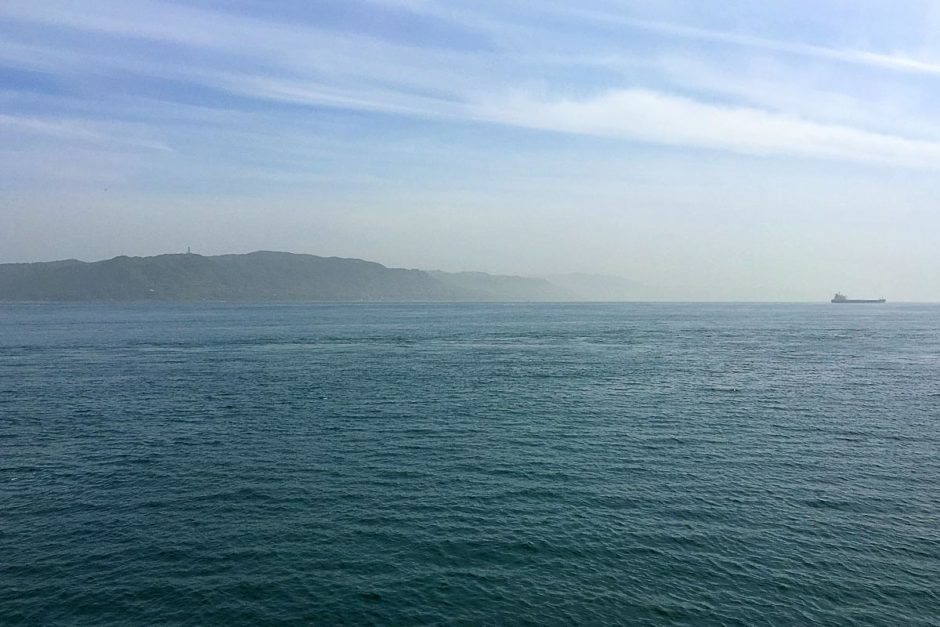
Awaji Island, fading in the distance.
When we exited the park, the lonesome politician was packing up his equipment, another day’s speechifyin’ over. Still, nobody was paying attention to him.
So, a little low all day but overall a nice and eye-opening visit to a place that’s very near Osaka but which I knew nothing about. Masayo said that in old times, Akashi was a sort of place of exile for people in the power center of Kyoto who had misbehaved. Not a prison exactly, but a far-flung outpost they would be banished to for a time.
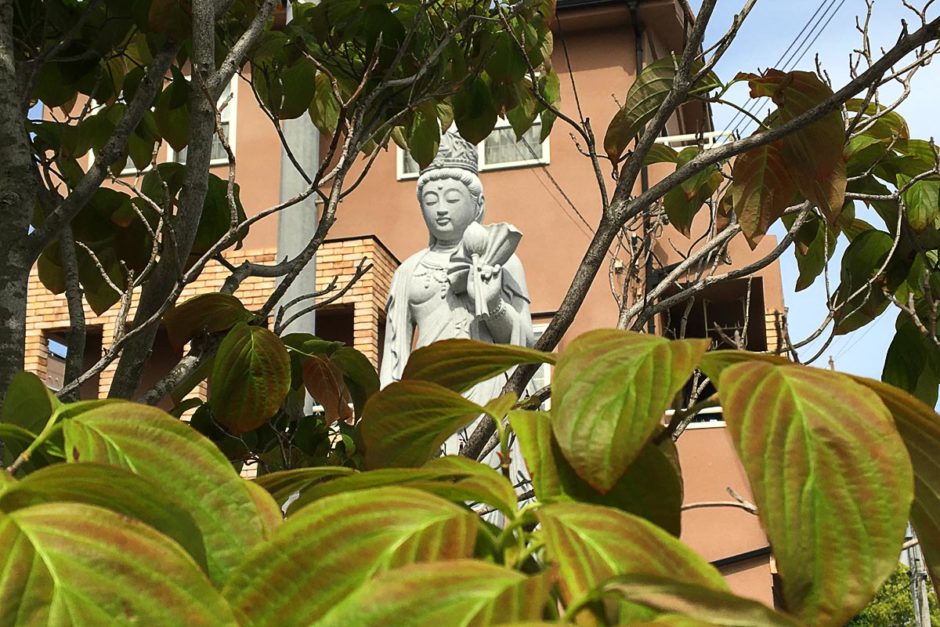
But when we were there it was a nice and friendly and self-contained little place, proud of its fresh daily seafood and its lack of pretension. Just the right size place for a mini-travel.
And my BG was 101 a couple hours later when I got home!
Thanks for reading. Suggested:
- Share:
- Read next: How I reached Bishanohana, Honshu's westernmost point
- News: Newsletter (posted for free on Patreon every week)
- Support: Patreon (watch extended, ad-free videos and get other perks)

Support independent travel content
You can support my work via Patreon. Get early links to new videos, shout-outs in my videos, and other perks for as little as $1/month.
Your support helps me make more videos and bring you travels from interesting and lesser-known places. Join us! See details, perks, and support tiers at patreon.com/t1dwanderer. Thanks!

looks like you had a good day but def too many octopus (octopai??) for my liking! i hate seafood, yuck!!! love the pic with your heads in the tree 🙂
Vicky-
I can’t pass a tree like that without getting all Rene Magritte with it. Imagine stopping a passing pedestrian and asking them to take the photo, which is what I did 😉
Sorry to hear you don’t like seafood! Maybe Akashi wouldn’t be for you. Or you’d be the one tourist going to the Italian restaurant in the middle of all the seafood shops :p